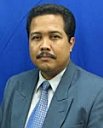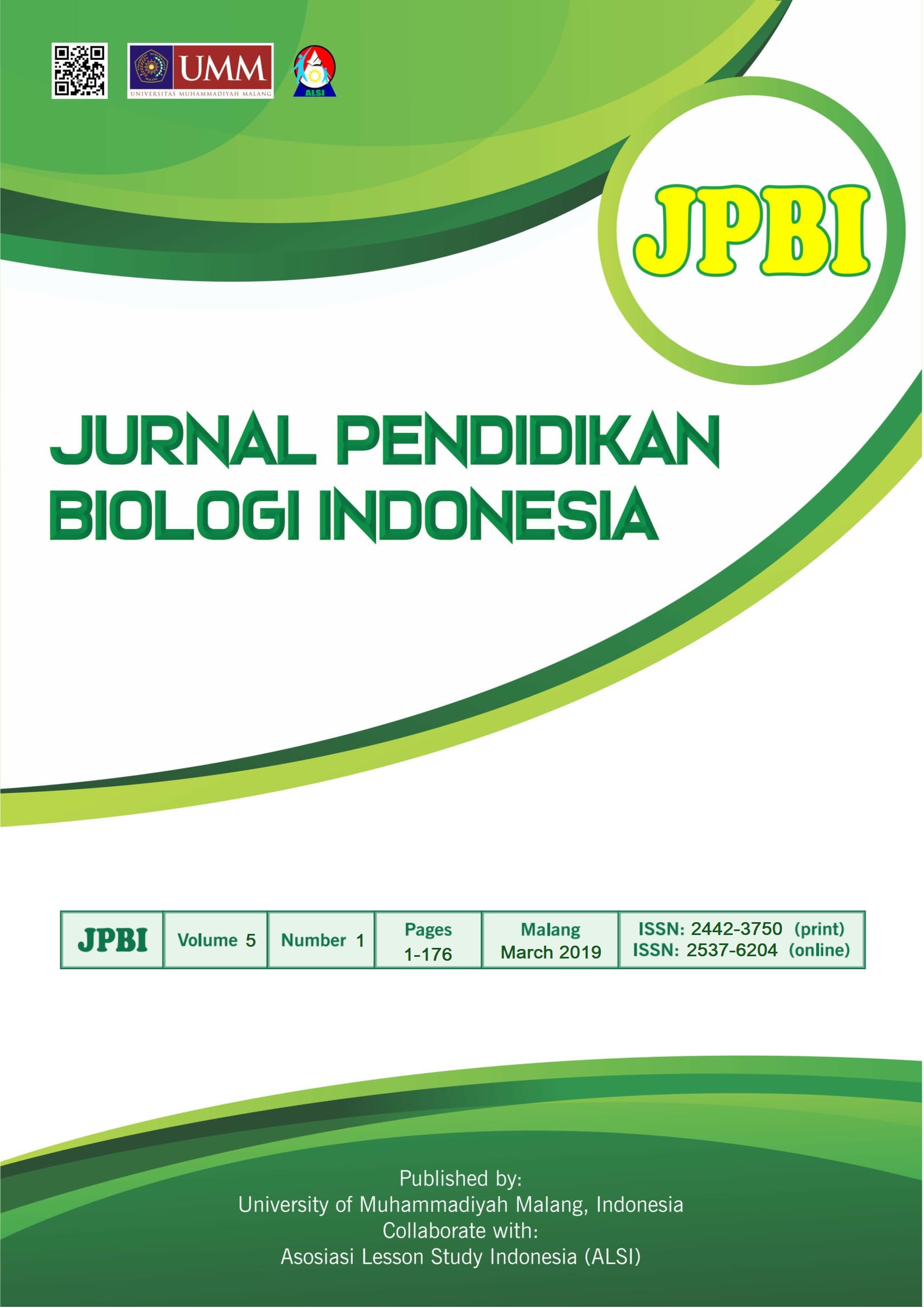Project-based learning: Improving students’ activity and comprehension through lesson study in senior high school
DOI:
https://doi.org/10.22219/jpbi.v5i1.7456Keywords:
Comprehension on concepts, learning sources, lesson study, project-based learningAbstract
Fostering teacher’s creativity can be facilitated by conducting Lesson Study (LS) which implementing Project-Based Learning (PjBL) using designing learning resources. This descriptive qualitative research was using a model teacher who did three open classes on ‘human reproduction system’ material and targeting the twelfth grade of senior high school students in Sumberpucung Malang as the research subject. The observers comprised three teachers and three lecturers. As for reflection in every open class, four students involved as the informants. The implementation of the model was considered very effective to improve the students’ learning activities, due to several reasons, namely: (a) almost all of the students were actively get involved in the learning process; (b) there was an improvement in the number of active students; (c) the instruction was positive to uplift the quality of classroom management; (d) the students were stimulated in formulating questions and giving opinions; (e) joyful learning was created; (f) most of the students had gained prior knowledge and comprehension of the given problems and concepts before they were presenting it.
Downloads
References
Anderman, E. M., Sinatra, G. M., & Gray, D. L. (2012). The challenges of teaching and learning about science in the twenty-first century: Exploring the abilities and constraints of adolescent learners. Studies in Science Education, 48(1), 89–117. doi: https://doi.org/10.1080/03057267.2012.655038
Arce, M. E., Miguez, J. L., Granada, E., Miguez, C., & Cacabelos, A. (2013). Project-based learning: Application to a research master subject of thermal engineering. Journal of Technology and Science Education, 3(3), 132–138. doi: https://doi.org/10.3926/jotse.81
Bell, S. (2010). Project-based learning for the 21st century: Skills for the future. The Clearing House: A Journal of Educational Strategies, Issues and Ideas, 83(2), 39–43. doi: https://doi.org/10.1080/000986 50903505415
Blazar, D., & Kraft, M. A. (2017). Teacher and teaching effects on students’ attitudes and behaviors. Educ Eval Policy Anal., 39(1), 146–170. doi: https://doi.org/10.3102/0162373716670260
Bouzeghoub, A., Do, K. N., & Lecocq, C. (2007). A situation-based delivery of learning resources in pervasive learning. In E. Duval, R. Klamma, & M. Wolpers (Eds.), Creating New Learning Experiences on a Global Scale, EC-TEL 2007 (pp. 450–456). Berlin, Heidelberg: Springer. doi: https://doi.org/10.1007/978-3-540-75195-3_36
Bryson, J. D. (2013). Engaging adult learners: Philosophy, principles and practices. Barrie, ON Canada: James David Bryson. Retrieved from http://northernc.on.ca/leid/docs/engagingadultlearners.pdf
Bušljeta, R. (2013). Effective use of teaching and learning resources. Czech-Polish Historical and Pedagogical Journal, 5(2), 55–69. doi: https://doi.org/10.2478/cphpj-2013-0014
Cajkler, W., Wood, P., Norton, J., Pedder, D., & Xu, H. (2015). Teacher perspectives about lesson study in secondary school departments: A collaborative vehicle for professional learning and practice development. Research Papers in Education, 30(2), 192–213. doi: https://doi.org/10.1080/02671522.20 14.887139
Carr, J. (2007). Approaches to teaching & learning. In INTO Consultative Conference on Education (pp. 1–112). Dublin: Irish National Teachers’ Organization. Retrieved from https://www.into.ie/ROI/Publications/ApproachesTeachingandLearning.pdf
Carroll, R. T. (2012). Becoming a critical thinker: A guide for the new millennium (2nd ed.). San Francisco: Pearson Learning Solutions. Retrieved from https://www.amazon.com/Becoming-Critical-Thinker-Guide-Millennium/dp/0536859345
Cartwright, R., Weiner, K., & Streamer-Veneruso, S. (2010). Student learning outcomes assessment handbook. Montgomery County, Maryland: Montgomery College. Retrieved from http://cms.montgomery college.edu/uploadedFiles/EDU/Departments_-_Academic/Outcomes_Assessment/sloa_handbook.pdf
Chiang, C. L., & Lee, H. (2016). The effect of project-based learning on learning motivation and problem-solving ability of vocational high school students. International Journal of Information and Education Technology, 6(9), 709–712. doi: https://doi.org/10.7763/IJIET.2016.V6.779
Coe, R., Aloisi, C., Higgins, S., & Major, L. E. (2014). What makes great teaching? Review of the underpinning research. Retrieved from https://www.suttontrust.com/wp-content/uploads/2014/10/What-Makes-Great-Teaching-REPORT.pdf
Cohen, D. K., Raudenbush, S. W., & Ball, D. L. (2003). Resources, instruction, and research. Educational Evaluation and Policy Analysis, 25(2), 119–142. Retrieved from https://www.jstor.org/stable/3699546
Coil, D., Wenderoth, M. P., Cunningham, M., & Dirks, C. (2010). Teaching the process of science: Faculty perceptions and an effective methodology. CBE Life Sciences Education, 9(4), 524–535. doi: https://doi. org/10.1187/cbe.10-01-0005
Crippen, K. J., Wu, C.-Y., Boyer, T., De Torres, T., Korolev, M., & Brucat, P. J. (2016). A pilot study of project-based learning in general chemistry for engineers. In ASEE Annual Conference and Exposition (Vol. 2016–June). New Orleans: American Society for Engineering Education. Retrieved from https:// asu.pure.elsevier.com/en/publications/a-pilot-study-of-project-based-learning-in-general-chemistry-for-
Darling-Hammond, L. (2006). Constructing 21st-century teacher education. Journal of Teacher Education, 57(3), 300–314. doi: https://doi.org/10.1177/0022487105285962
Dickinson, G., & Jackson, J. K. (2008). Planning for success: How to design and implement project-based science activities. In The Science Teacher (pp. 29–32). Retrieved from https://gato-docs.its.txstate.edu /jcr:50c9487f-0e5d-4b2d-81bf-a8ef6cd1b601/Dickinson 1.pdf
Dunlosky, J., Rawson, K. A., Marsh, E. J., Nathan, M. J., & Willingham, D. T. (2013). Improving students’ learning with effective learning techniques: Promising directions from cognitive and educational psychology. Psychological Science in the Public Interest, 14(1), 4–58. doi: https://doi.org/10.1177/152 91006 12453266
Fadly, W., & Wasis. (2017). Fostering students’ scientific communication through PjBL-based communication activities. IOSR Journal of Research & Method in Education, 7(3), 21–26. doi: https://doi.org/10.9790/73 88-0703022126
Fullan, M., & Langworthy, M. (2014). A rich seam: How new pedagogies find deep learning. London: Pearson. Retrieved from https://www.michaelfullan.ca/wp-content/uploads/2014/01/3897.Rich_Seam_web.pdf
Greenstein, L. (2012). Assessing 21st century skills: A guide to evaluating mastery and authentic learning. California United State of America: Corwin Press. Retrieved from https://us.corwin.com/en-us/nam/as sessing-21st-century-skills/book237748
Guardino, C. A., & Fullerton, E. (2010). Changing behaviors by changing the classroom environment. TEACHING Exceptional Children, 42(6), 8–13. doi: https://doi.org/10.1177/004005991004200601
Hightower, A. M., Delgado, R. C., Lloyd, S. C., Wittenstein, R., Sellers, K., & Swanson, C. B. (2011). Improving student learning by supporting quality teaching: Key issues, effective strategies. Bethesda, MD. Retrieved from https://www.edweek.org/media/eperc_qualityteaching_12.11.pdf
Hodge, S., & Anderson, B. (2007). Teaching and learning with an interactive whiteboard: A teacher’s journey. Learning, Media and Technology, 32(3), 271–282. doi: https://doi.org/10.1080/17439880701511123
Holubova, R. (2008). Effective teaching methods — Project-based learning in physics. US-China Education Review, 5(12), 27–36. Retrieved from https://files.eric.ed.gov/fulltext/ED504949.pdf
Hunt, J. R. (2015). Pace classes: Needs assessment, syllabus design and materials selection. Hitotsubashi Journal of Commerce and Management, 49(1), 55–71. Retrieved from https://www.jstor.org/stable/ 43697709
Husamah, & Pantiwati, Y. (2014). Cooperative learning STAD-PjBL: Motivation, thinking skills, and learning outcomes of Biology Department students. International Journal of Education Learning and Development, 2(1), 77–94. Retrieved from https://www.eajournals.org/journals/international-journal-of-education-learning-and-development-ijeld/vol-2-issue-1-march-2014/cooperative-learning-stad-pjbl
Isabekov, A., & Sadyrova, G. (2018). Project-based learning to develop creative abilities in students. In J. Drummer, G. Hakimov, M. Joldoshov, T. Köhler, & S. Udartseva (Eds.), Vocational Teacher Education in Central Asia. Technical and Vocational Education and Training: Issues, Concerns and Prospects (pp. 43–49). Springer, Cham. doi: https://doi.org/10.1007/978-3-319-73093-6_4
Kamina, P., & Iyer, N. N. (2009). From concrete to abstract: Teaching for transfer of learning when using manipulatives. In NERA Conference Proceedings 2009. (pp. 1–9). Northeastern Educational Research Association. Retrieved from http://digitalcommons.uconn.edu/nera_2009/6
Karamustafaoglu, O. (2009). Active learning strategies in physics teaching. Energy Education Science and Technology Part B: Social and Educational Studies, 1(1), 27–50. Retrieved from https://files.eric.ed.gov/fulltext/ED504252.pdf
Khalil, M. K., & Elkhider, I. A. (2016). Applying learning theories and instructional design models for effective instruction. Advances in Physiology Education, 40(2), 147–156. doi: https://doi.org/10.1152/advan.00 138. 2015
Kohl, H. W., Castelli, D. M., Chen, A., Eyler, A. A., Going, S., Greenberg, J. D., … Woodward-Lopez, G. (2013). Educating the student body: Taking physical activity and physical education to school. (H. W. Kohl & H. D. Cook, Eds.). Washington (DC): National Academies Press. https://doi.org/10.17226/ 18314
Kokotsaki, D., Menzies, V., & Wiggins, A. (2016). Project-based learning: A review of the literature. Improving Schools, 19(3), 267–277. doi: https://doi.org/10.1177/1365480216659733
Koper, E. J. R. (2003). Combining reusable learning resources and services to pedagogical purposeful units of learning. In A. Littlejohn (Ed.), Reusing Online Resources: A Sustainable Approach to eLearning (pp. 46–59). London: Kogan Page. Retrieved from http://hdl.handle.net/1820/39
Lento, E. M., Schleicher, A., Golden, M., Wilson, L., Koh, T. S., Prakash, A., … Lewis, B. (2014). Transforming education for the next generation: A practical guide to learning and teaching with technology. (J. Rowell, Ed.). Intel® Education. Retrieved from https://www.intel.com/content/dam/www/ public/us/en/documents/guides/transforming-education-next-generation-guide.pdf
Masino, S., & Niño-Zarazúa, M. (2016). What works to improve the quality of student learning in developing countries? International Journal of Educational Development, 48, 53–65. doi: https://doi.org/10.1016/j. ijedud ev.2015.11.012
Movahedzadeh, F., Patwell, R., Rieker, J. E., & Gonzalez, T. (2012). Project-based learning to promote effective learning in biotechnology courses. Education Research International, 1–8. doi: https://doi.org/ 10.1155/2012/536024
Niemi, H. (2009). Why from teaching to learning? European Educational Research Journal, 8(1), 1–17. doi: https:// doi.org/10.2304/eerj.2009.8.1.1
Rosenshine, B. (2012). Principles of instruction: Research-based strategies that all teachers should know. American Educator, 36(1), 12–19, 39. Retrieved from https://www.aft.org/sites/default/files/periodicals/ Rosenshine.pdf
Saito, E., & Atencio, M. (2014). Lesson study for learning community (LSLC): Conceptualising teachers’ practices within a social justice perspective. Discourse: Studies in the Cultural Politics of Education, 36(6), 795–807. doi: https://doi.org/10.1080/01596306.2014.968095
Sani, R. A. (2014). Pembelajaran saintifik untuk implementasi kurikulum 2013. (Y. S. Hayati, Ed.). Jakarta: Bumi Aksara. Retrieved from https://www.researchgate.net/publication/320540068
Savery, J. R. (2006). Overview of problem-based learning: definitions and distinctions. Interdisciplinary Journal of Problem-Based Learning, 1(1), 13. doi: https://doi.org/10.7771/1541-5015.1002
Shinde, V. (2014). Design of course level project based learning models for an Indian Engineering Institute: An assessment of students‘ learning experiences and learning outcomes. Aalborg University Press, Denmark. Retrieved from http://vbn.aau.dk/files/205577624/VIKAS_SHINDE_Thesis.pdf
Sumarti, S. S., Cahyono, E., & Munafiah, A. (2015). Project based learning tools development on salt hydrolysis materials through scientific approach. IOSR Journal of Research & Method in Education, 5(2), 1–5. doi: https://doi.org/10.9790/7388-05220105
Walberg, H. J. (2010). Improving student learning: Action principles for families, classrooms, schools, districts, and states. Lincoln: Information Age Publishing, Inc. Retrieved from https://eric.ed.gov/?id=ED 529526
Downloads
Published
Issue
Section
License
Authors who publish with JPBI (Jurnal Pendidikan Biologi Indonesia) agree to the following terms:
- For all articles published in JPBI, copyright is retained by the authors. Authors give permission to the publisher to announce the work with conditions. When the manuscript is accepted for publication, the authors agree to automatic transfer of the publishing right to the publisher.
- Authors retain copyright and grant the journal right of first publication with the work simultaneously licensed under a Creative Commons Attribution-ShareAlike 4.0 International License that allows others to share the work with an acknowledgment of the work's authorship and initial publication in this journal.
- Authors are able to enter into separate, additional contractual arrangements for the non-exclusive distribution of the journal's published version of the work (e.g., post it to an institutional repository or publish it in a book), with an acknowledgment of its initial publication in this journal.
- Authors are permitted and encouraged to post their work online (e.g., in institutional repositories or on their website) prior to and during the submission process, as it can lead to productive exchanges, as well as earlier and greater citation of published work (See The Effect of Open Access).

This work is licensed under a Creative Commons Attribution-ShareAlike 4.0 International License.



















